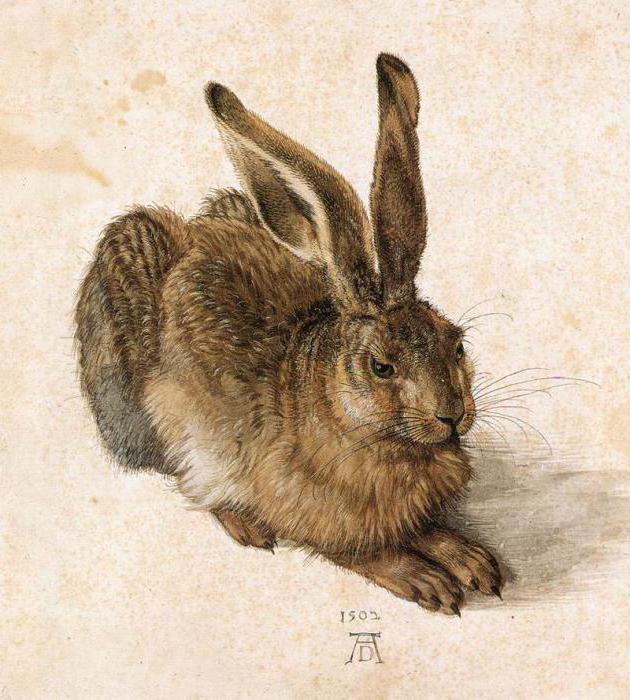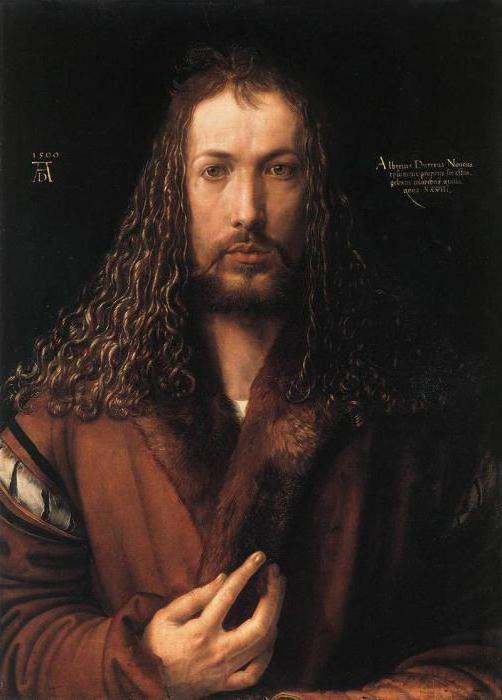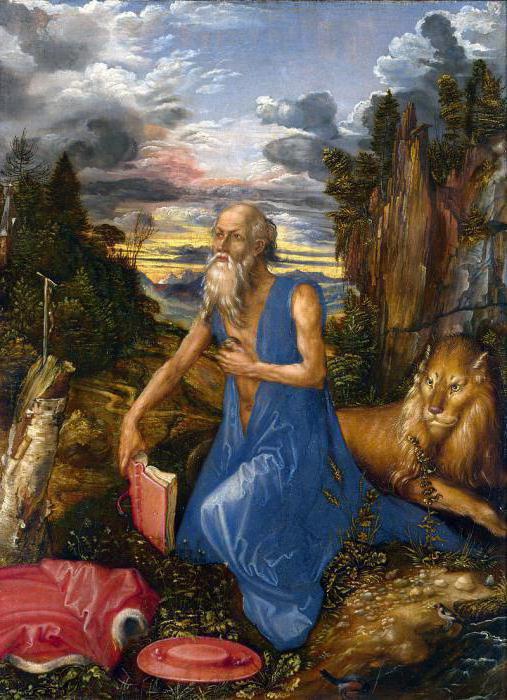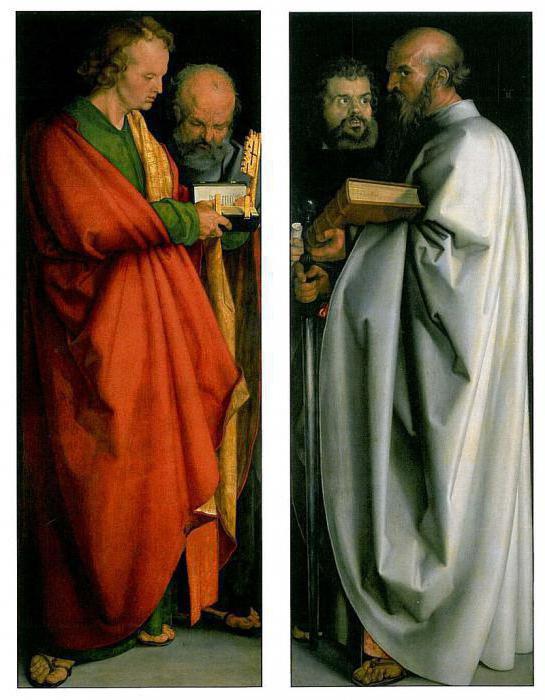A. Dürer (1471-1528) - a great German artist, and in the last years of his life and an art theorist. His biography and work are closely related to the Renaissance. The works of Albrecht Durer and today attract many connoisseurs of painting. Want to know more about him? The life and work of Albrecht Durer are presented in this article.
short biography
His father was a native of Hungary, a master of silver. Albrecht studied first with his father, and then with Michael Wolgemut, a painter and engraver from Nuremberg. 1490-1494 - "years of wandering", mandatory in order to obtain the title of master. Albrecht spent this time in the cities of the Upper Rhine (Strasbourg, Colmar, Basel). Here he entered the circle of typographers and humanists. It is known that Dürer wanted to improve in a metal engraving by M. Schogauer in Colmar, but did not find him alive. Then Albrecht began to study the work of this master, communicating with his sons, who were also artists.
In 1494, Albrecht Durer returned to Nuremberg. His biography and work were marked at this time by important events. It was then that the marriage to Agnes Frey took place, as well as the opening of his own workshop. After some time, Albrecht decided to take a new trip, this time choosing Northern Italy. He visited Padua and Venice in 1494-95. Durer traveled to Venice in 1505, stayed there until 1507. The acquaintance of Albrecht with Emperor Maximilian I dates back to 1512. Apparently, at the same time, Dürer began to work for him, until the death of Maximilian, which occurred in 1519. It is known that Albrecht also visited the Netherlands. In the period from 1520 to 1521, he visited cities such as Brussels, Antwerp, Ghent, Bruges, Malin and others.
Durer's creativity
Albrecht Dürer, whose biography and work coincides with the heyday of the German Renaissance, could not stay away from the trends of his time. It was a difficult, largely disharmonious period. His character left its mark on all forms of art. The revival in the works of Albrecht accumulates the originality and richness of German artistic traditions. They appear in the guise of Dürer's characters, far from beauty in terms of the classical ideal. In addition, the master prefers everything sharp-characteristic, pays great attention to individual details. Of great importance for Albrecht is at the same time contact with the art of Italy. The creativity of Albrecht Durer is marked by the fact that he tried to comprehend the secret of his perfection and harmony. Dürer is the only representative of the Northern Renaissance, which in terms of its versatility and orientation of interests, the desire to comprehend the laws of art, to create perfect proportions of human figures can be put on a par with the great masters of the Italian Renaissance.
Drawings
The work of Albrecht Durer is diverse. He was gifted as a draftsman, engraver and painter. At the same time, the engraving and drawing sometimes occupy even a leading place. More than 900 sheets totals the legacy of the Dürer-draftsman. By its diversity and vastness it can only be compared with the works of Leonardo da Vinci. Apparently, painting was part of the master’s daily life. Dürer was well versed in all the graphic techniques of the time - from coal, watercolors, Italian pencil to reed feathers and silver pins. As for the Italian masters, the drawing became for Dürer the most important stage in creating the composition. This stage included studies, sketches of heads, legs, arms, draperies.

For Dürer, drawing was a tool with which he studied the characteristic types - Nuremberg fashionistas, elegant gentlemen, and peasants. The famous works of Albrecht Dürer - watercolors of the master "Hare" (pictured above) and "A piece of turf." They are made with a chilly detachment and such keenness that they could become illustrations for scientific codes.
Series of landscapes
The first significant work of the master is a series of landscapes from 1494-95. These works of Albrecht Durer were painted with watercolors and gouache during his trip to Italy. They are carefully balanced, thoughtful compositions, with spatial plans smoothly alternating with each other. These works of Albrecht Durer are the first “pure” landscapes in the history of European art.
Christmas, Adoration of the Magi, Adam and Eve
A clear even mood, the author’s desire for a harmonious balance of rhythms and forms - these are the characteristic features of Dürer painting from the end of the 15th century to the beginning of the second decade of the 16th century. This is the altar "Christmas", completed around 1498, and the work "Adoration of the Magi" dating back to 1504, in which Dürer unites a group of three magi and Madonna with flowing silhouettes, a calm circular rhythm, as well as an arch motif that is repeated several times in the architectural decoration. In the 1500s, one of the main topics of Albrecht's work was the desire to find the ideal proportions of the human body. He searches for their secrets, drawing naked female and male figures. Note that it was Albrecht who was the first in Germany to begin to study nudity. These searches were summarized in the engraving of 1504 "Adam and Eve", as well as in a large painting diptych of the same name completed about 1507.
"Adoration of the Holy Trinity" and "Feast of the Rosary"
Albrecht Dürer already performed the most complex works, harmoniously painted compositions of many figures, already in the years of his creative maturity. His famous works include the "Feast of the Rosary," created in 1506, and in 1511, the "Adoration of the Holy Trinity." The Feast of the Rosary is one of Dürer’s greatest works (161.5 x 192 cm). In addition, this is one of the most major intonation paintings. The work is close to the art of Italian masters not only with motives, but also with its vitality, the full sound of colors, the full-blooded images (mainly portrait ones), the balance of composition, and the breadth of writing. In the painting entitled “Adoration of the Holy Trinity”, which is a small altar work, the rhythmic semicircles, which overlap with the arched completion of the altar, combine angels floating in the heavens, the Church Fathers and the host of saints. This picture resembles Raphael's Dispute.
Early portraits

Without portraits, it is difficult to imagine the work of Albrecht Durer. His paintings in this genre are numerous and very interesting. Albrecht already in his early work, completed around 1499 (portrait of Oswald Krel), appears to be an established master. It perfectly conveys the internal energy of the model, the originality of character. The uniqueness of Albrecht Durer lies in the fact that the self-portrait takes a leading place in the early period of his portrait work. As early as 1484, he created a silver pin pattern, presented at the beginning of the article. Here Albrecht is depicted as a 13-year-old child. Already at that time, Dürer’s hand was driven by a craving for self-knowledge, which was further developed in his first three picturesque self-portraits. We are talking about the works of 1493, 1498 and 1500. In the last work (her photo is presented above) Albrecht is depicted strictly in front. Framed by a small beard and long hair, his regular face reminds us of the image of Christ the Pantocrator.
Engraving
The work of Albrecht Durer (1471-1528) is interesting in that he performed prints equally successfully on copper and wood. Albrecht turned the engraving, following Schongauer, into one of the main forms of art. In the works of Dürer, the restless, restless spirit of his creative nature received expression, as well as the dramatic moral conflicts that worried him. A sharp contrast to the master’s clear and calm early paintings was the first large-scale graphic series consisting of 15 engravings on the themes of the Apocalypse. These works, made on wood, Albrecht created in 1498. Dürer in his engravings much more than in paintings, relies on German traditions. They are manifested in the tension of angular, sharp movements, excessive expression of images, the rhythm of swirling, rapid lines and breaking folds. The image of Fortune from the engraving engraving "Nemesis", dating back to the beginning of 1500, has a formidable character. This engraving is considered one of the best works of Dürer.
"Life of Mary", "Big Passion" and "Small Passion"
In the graphic cycle "The Life of Mary", created around 1502-05, the author's interest in genre details, as well as an abundance of details, are features that are characteristic of the German art tradition. This graphic cycle is the most clear and calm in mood. The other two, dedicated to the passions of Christ, are characterized by dramatic expression. These are executed on a tree "Big Passion" (circa 1498-1510), as well as two series of copper engravings "Small Passion" (years of creation - 1507-13 and 1509-11). These works of Dürer were most famous among his contemporaries.
Triptych 1513-1514

The engraving of 1513 “The Knight, Death and the Devil”, as well as two works of 1514 (“Jerome in the Cell” and “Melancholy”) occupy an important place in the heritage of Albrecht. They form a kind of triptych. These works are performed by a master with masterly subtlety. They are distinguished by a rare figurative concentration and conciseness. Apparently, Dürer did not intend to create them as a single cycle. Nevertheless, these works are united by a moral and philosophical subtext, which is very complex (many works are devoted to its interpretation today). Apparently, the treatise "Guide to the Christian Warrior" by E. Rotterdam was inspired by the author's image of a middle-aged, stern warrior who is moving towards an unknown target, despite the Devil on his heels, as well as the threat of Death. The warrior is represented on the background of a rocky wild landscape. The work of Albrecht Durer is not always easily perceived. The summary of the above treatise is important to know to understand the image of a warrior.
Saint Jerome (pictured above), who has all gone into scientific studies, is the personification of a contemplative life and spiritual self-deepening. The majestic winged Melancholy, immersed in its gloomy reflection, is presented against the background of a chaotic pile of symbols of fast-flowing time and sciences, tools of craft.
It is usually interpreted as the personification of the creative, restless spirit of a person. It should be noted that the humanists of the Renaissance found in people with a melancholic temperament the "divine obsession" of genius, the embodiment of creativity. Therefore, we can say that in the framework of the general trend is the work of Albrecht Durer. Briefly describe his later work.
Late work
Durer after 1514 worked at the court of Maximilian I (above is his portrait, made by Albrecht). At this time, Albrecht Dürer performed many official orders. The works created by him required great skill, but the most time-consuming of them was colored lithography, executed on 192 boards. This work is called "Arch of Maximilian I". A large group of artists worked on its creation, except for Dürer. After a trip to the Netherlands, completed in 1520-21, a new creative upsurge began at Albrecht. At this time, a lot of fluent sketches appeared. In addition, the works of Albrecht Dürer were replenished with a number of beautiful graphic portraits . Their list is as follows: "Erasmus of Rotterdam" made in coal in 1520 , as well as the work of 1521, "Luca of Leiden" (made with silver pencil), "Agnes Durer", which was created using a metal pencil, etc.
Portraits of the 1520s
Portrait in the 1520s became the main genre in the work of Dürer. At this time, Albrecht Dürer created images in copper engraving of the most prominent humanists of his time. The main works are as follows: in 1526 - a portrait of Philip Melanchthon, in 1524 - Willibald Pirkheim, in 1526 - Erasmus of Rotterdam. In painting in 1521, "Portrait of a Young Man" appears, in 1524 - "Portrait of a Man", in 1526 - "Jerome Holzshuer" and other works. These small works are distinguished by an impeccable composition, classic completeness, and embossed silhouettes. They are spectacularly complicated by the shape of huge velvet berets or wide-brimmed hats. The compositional center of these works is a close-up person created by subtle transitions of shadows and light. In a barely noticeable facial expression, in the gaze of wide-open eyes, in the outlines of lips slightly bent in a smile or half-open, in the energetic drawing of the cheekbones and the movement of frowning eyebrows, one can see the traces of an intense spiritual life. The strength of mind discovered by Albrecht in his contemporaries takes on a large scale in the diptych “The Four Apostles” (pictured below), the last pictorial work of the master (1525). It was written by Dürer for the Nuremberg City Hall. Huge figures of the Evangelist Mark, the apostles Paul, Peter and John are represented, which, according to the contemporaries of the master, personify 4 temperaments.

Theoretical work, the value of creativity
In the last years of his life, Albrecht published theoretical works: a guide on measuring with a ruler and compasses (in 1525), on strengthening fortresses, castles and cities (1527), and in 1528 the work “Four books on human proportions” appeared. Albrecht Durer, whose work and destiny were examined by us, died in Nuremberg on April 6, 1528.
Dürer strongly influenced the development of all German art in the first half of the 16th century. His engravings in Italy were very successful - even their fakes were produced. Many Italian artists were affected by his work, including Pordenone and Pontormo.